Page 49 of 370
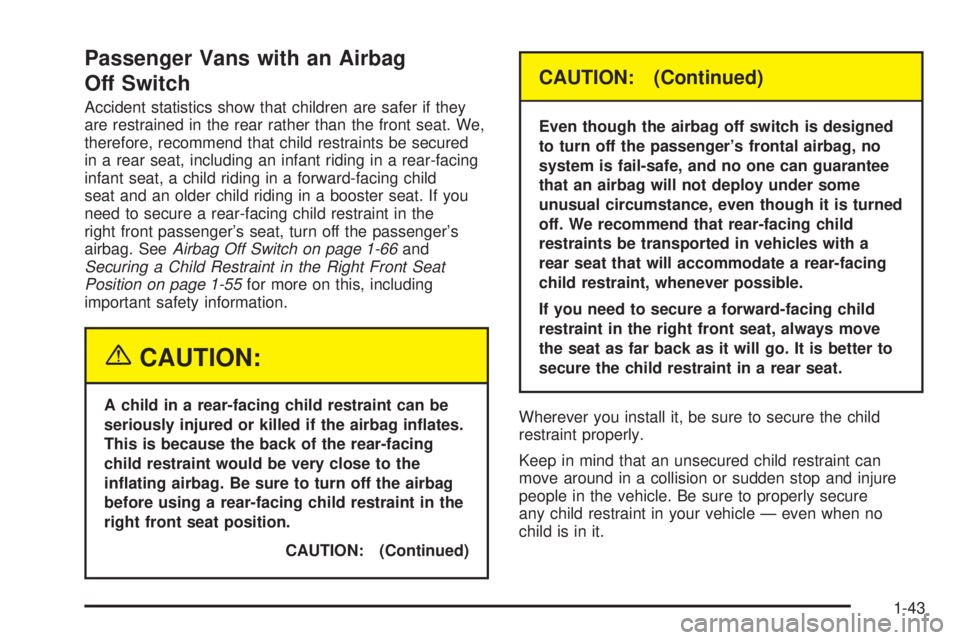
Passenger Vans with an Airbag
Off Switch
Accident statistics show that children are safer if they
are restrained in the rear rather than the front seat. We,
therefore, recommend that child restraints be secured
in a rear seat, including an infant riding in a rear-facing
infant seat, a child riding in a forward-facing child
seat and an older child riding in a booster seat. If you
need to secure a rear-facing child restraint in the
right front passenger’s seat, turn off the passenger’s
airbag. SeeAirbag Off Switch on page 1-66and
Securing a Child Restraint in the Right Front Seat
Position on page 1-55for more on this, including
important safety information.
{CAUTION:
A child in a rear-facing child restraint can be
seriously injured or killed if the airbag in�ates.
This is because the back of the rear-facing
child restraint would be very close to the
in�ating airbag. Be sure to turn off the airbag
before using a rear-facing child restraint in the
right front seat position.
CAUTION: (Continued)
CAUTION: (Continued)
Even though the airbag off switch is designed
to turn off the passenger’s frontal airbag, no
system is fail-safe, and no one can guarantee
that an airbag will not deploy under some
unusual circumstance, even though it is turned
off. We recommend that rear-facing child
restraints be transported in vehicles with a
rear seat that will accommodate a rear-facing
child restraint, whenever possible.
If you need to secure a forward-facing child
restraint in the right front seat, always move
the seat as far back as it will go. It is better to
secure the child restraint in a rear seat.
Wherever you install it, be sure to secure the child
restraint properly.
Keep in mind that an unsecured child restraint can
move around in a collision or sudden stop and injure
people in the vehicle. Be sure to properly secure
any child restraint in your vehicle — even when no
child is in it.
1-43
Page 50 of 370
Cargo Vans and Cab and Chassis
Models without an Airbag Off Switch
The child restraint must be secured properly in the right
front passenger seat. If your vehicle has a passenger
airbag,neveruse a rear-facing child restraint in this
vehicle Here is why:
{CAUTION:
A child in a rear-facing child restraint can be
seriously injured or killed if the passenger’s
airbag in�ates. This is because the back of the
rear-facing child restraint would be very close
to the in�ating airbag. Do not use a rear-facing
child restraint in this vehicle.
CAUTION: (Continued)
CAUTION: (Continued)
If you need to secure a forward-facing child
restraint in the front passenger position,
always move the front passenger seat as far
back as it will go.
Keep in mind that an unsecured child restraint can
move around in a collision or sudden stop and injure
people in the vehicle. Be sure to properly secure
any child restraint in your vehicle — even when no child
is in it.
1-44
Page 51 of 370
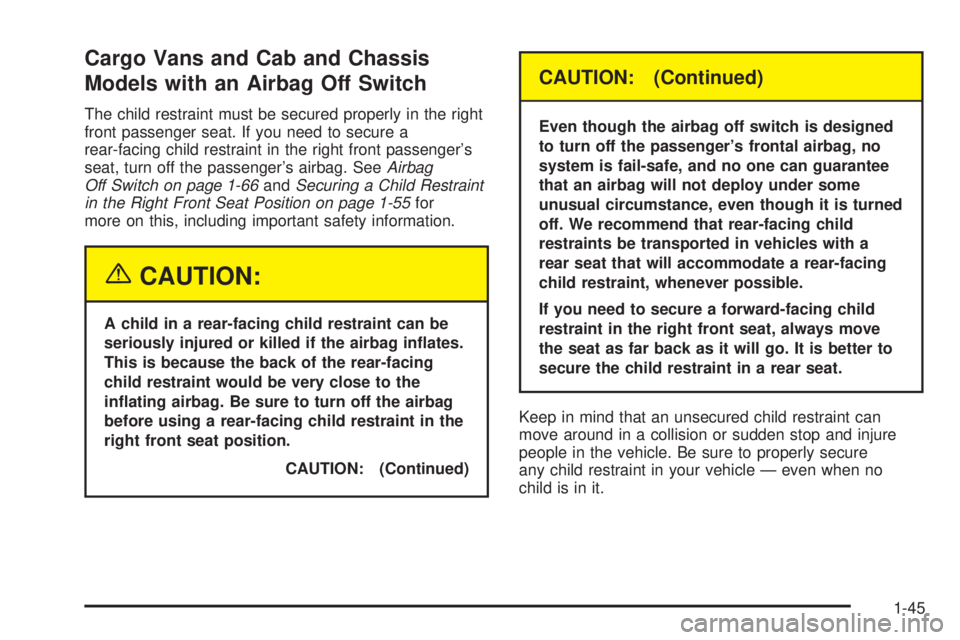
Cargo Vans and Cab and Chassis
Models with an Airbag Off Switch
The child restraint must be secured properly in the right
front passenger seat. If you need to secure a
rear-facing child restraint in the right front passenger’s
seat, turn off the passenger’s airbag. SeeAirbag
Off Switch on page 1-66andSecuring a Child Restraint
in the Right Front Seat Position on page 1-55for
more on this, including important safety information.
{CAUTION:
A child in a rear-facing child restraint can be
seriously injured or killed if the airbag in�ates.
This is because the back of the rear-facing
child restraint would be very close to the
in�ating airbag. Be sure to turn off the airbag
before using a rear-facing child restraint in the
right front seat position.
CAUTION: (Continued)
CAUTION: (Continued)
Even though the airbag off switch is designed
to turn off the passenger’s frontal airbag, no
system is fail-safe, and no one can guarantee
that an airbag will not deploy under some
unusual circumstance, even though it is turned
off. We recommend that rear-facing child
restraints be transported in vehicles with a
rear seat that will accommodate a rear-facing
child restraint, whenever possible.
If you need to secure a forward-facing child
restraint in the right front seat, always move
the seat as far back as it will go. It is better to
secure the child restraint in a rear seat.
Keep in mind that an unsecured child restraint can
move around in a collision or sudden stop and injure
people in the vehicle. Be sure to properly secure
any child restraint in your vehicle — even when no
child is in it.
1-45
Page 53 of 370
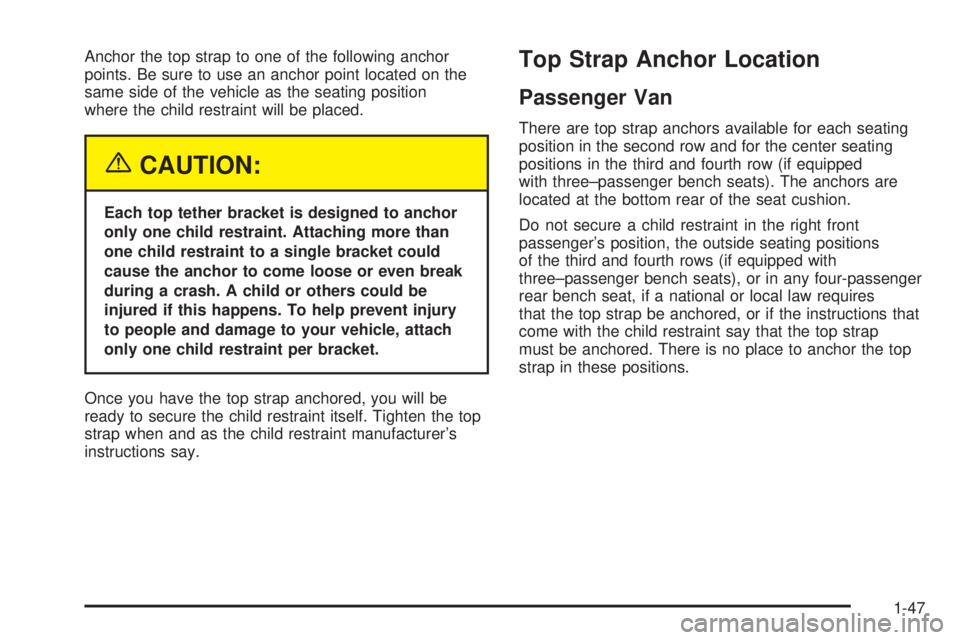
Anchor the top strap to one of the following anchor
points. Be sure to use an anchor point located on the
same side of the vehicle as the seating position
where the child restraint will be placed.
{CAUTION:
Each top tether bracket is designed to anchor
only one child restraint. Attaching more than
one child restraint to a single bracket could
cause the anchor to come loose or even break
during a crash. A child or others could be
injured if this happens. To help prevent injury
to people and damage to your vehicle, attach
only one child restraint per bracket.
Once you have the top strap anchored, you will be
ready to secure the child restraint itself. Tighten the top
strap when and as the child restraint manufacturer’s
instructions say.
Top Strap Anchor Location
Passenger Van
There are top strap anchors available for each seating
position in the second row and for the center seating
positions in the third and fourth row (if equipped
with three–passenger bench seats). The anchors are
located at the bottom rear of the seat cushion.
Do not secure a child restraint in the right front
passenger’s position, the outside seating positions
of the third and fourth rows (if equipped with
three–passenger bench seats), or in any four-passenger
rear bench seat, if a national or local law requires
that the top strap be anchored, or if the instructions that
come with the child restraint say that the top strap
must be anchored. There is no place to anchor the top
strap in these positions.
1-47
Page 55 of 370
Lower Anchorages and Top Tethers
for Children (LATCH System)
Your vehicle may have the LATCH system. If it does,
you will �nd two sets of anchors in the second row
of seats in the outside seating positions, where
the seatback meets the seat cushion.
This system, designed to make installation of child
restraints easier, does not use the vehicle’s safety belts.
Instead, it uses vehicle anchors and child restraint
attachments to secure the restraints. Some restraints
also use another vehicle anchor to secure a top
tether strap.
A. Lower Anchorage
B. Lower Anchorage
C. Top Tether
1-49
Page 56 of 370
A. Lower Anchorage
B. Lower Anchorage
In order to use the LATCH system in your vehicle, you
need a child restraint designed for that system.To assist you in locating
the lower anchors for this
child restraint system, each
seating position with the
LATCH system has a label
on the seatback at each
lower anchor position.
The LATCH system labels are located in the second
row outside seating positions.
{CAUTION:
If a LATCH-type child restraint is not attached
to its anchorage points, the restraint will not
be able to protect the child correctly. In a
crash, the child could be seriously injured or
killed. Make sure that a LATCH-type child
restraint is properly installed using the
anchorage points, or use the vehicle’s safety
belts to secure the restraint, following the
instructions that came with that restraint, and
also the instructions in this manual.
1-50
Page 57 of 370
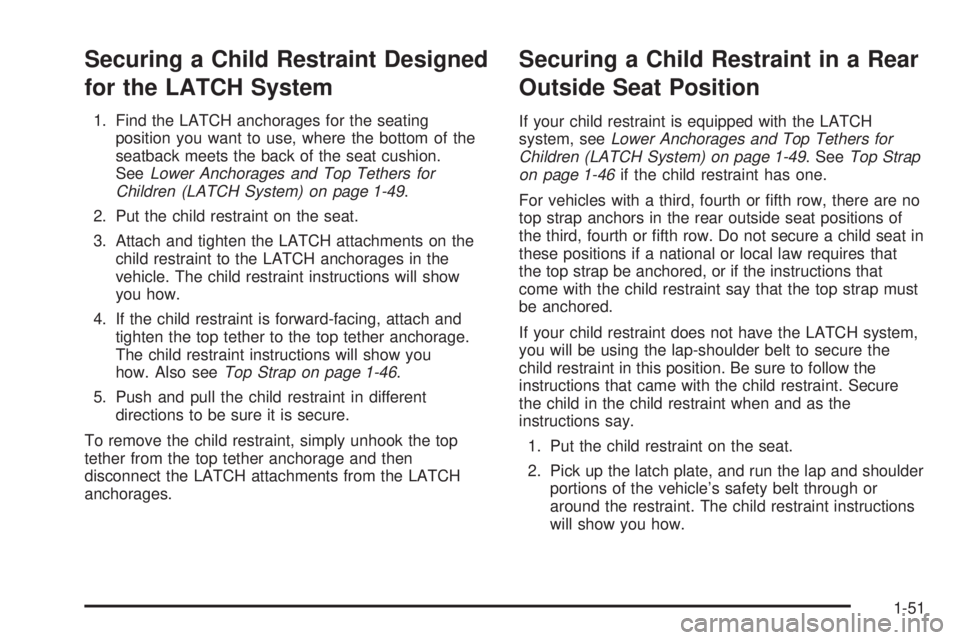
Securing a Child Restraint Designed
for the LATCH System
1. Find the LATCH anchorages for the seating
position you want to use, where the bottom of the
seatback meets the back of the seat cushion.
SeeLower Anchorages and Top Tethers for
Children (LATCH System) on page 1-49.
2. Put the child restraint on the seat.
3. Attach and tighten the LATCH attachments on the
child restraint to the LATCH anchorages in the
vehicle. The child restraint instructions will show
you how.
4. If the child restraint is forward-facing, attach and
tighten the top tether to the top tether anchorage.
The child restraint instructions will show you
how. Also seeTop Strap on page 1-46.
5. Push and pull the child restraint in different
directions to be sure it is secure.
To remove the child restraint, simply unhook the top
tether from the top tether anchorage and then
disconnect the LATCH attachments from the LATCH
anchorages.
Securing a Child Restraint in a Rear
Outside Seat Position
If your child restraint is equipped with the LATCH
system, seeLower Anchorages and Top Tethers for
Children (LATCH System) on page 1-49. SeeTop Strap
on page 1-46if the child restraint has one.
For vehicles with a third, fourth or �fth row, there are no
top strap anchors in the rear outside seat positions of
the third, fourth or �fth row. Do not secure a child seat in
these positions if a national or local law requires that
the top strap be anchored, or if the instructions that
come with the child restraint say that the top strap must
be anchored.
If your child restraint does not have the LATCH system,
you will be using the lap-shoulder belt to secure the
child restraint in this position. Be sure to follow the
instructions that came with the child restraint. Secure
the child in the child restraint when and as the
instructions say.
1. Put the child restraint on the seat.
2. Pick up the latch plate, and run the lap and shoulder
portions of the vehicle’s safety belt through or
around the restraint. The child restraint instructions
will show you how.
1-51
Page 59 of 370
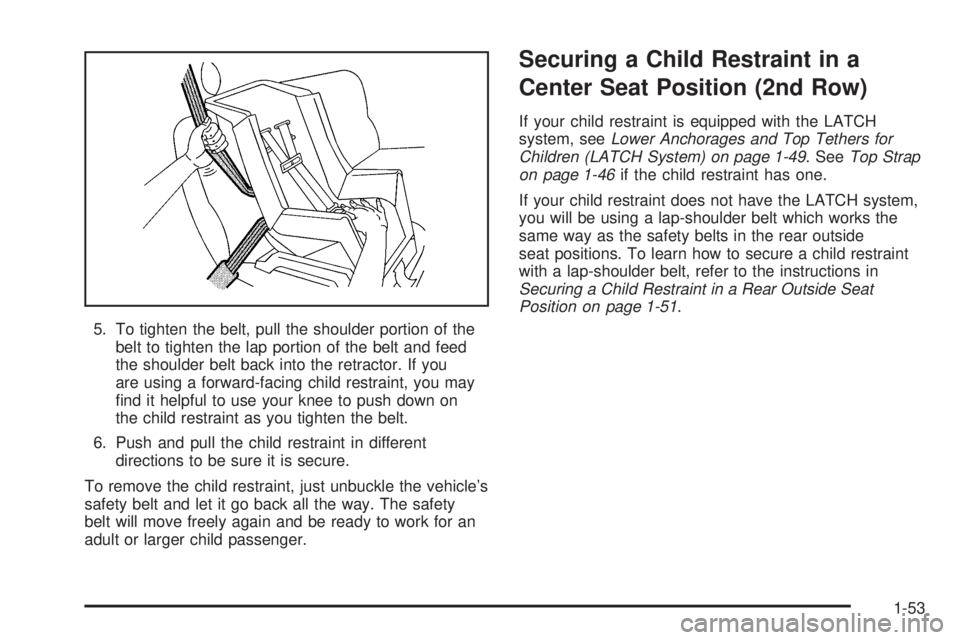
5. To tighten the belt, pull the shoulder portion of the
belt to tighten the lap portion of the belt and feed
the shoulder belt back into the retractor. If you
are using a forward-facing child restraint, you may
�nd it helpful to use your knee to push down on
the child restraint as you tighten the belt.
6. Push and pull the child restraint in different
directions to be sure it is secure.
To remove the child restraint, just unbuckle the vehicle’s
safety belt and let it go back all the way. The safety
belt will move freely again and be ready to work for an
adult or larger child passenger.
Securing a Child Restraint in a
Center Seat Position (2nd Row)
If your child restraint is equipped with the LATCH
system, seeLower Anchorages and Top Tethers for
Children (LATCH System) on page 1-49. SeeTop Strap
on page 1-46if the child restraint has one.
If your child restraint does not have the LATCH system,
you will be using a lap-shoulder belt which works the
same way as the safety belts in the rear outside
seat positions. To learn how to secure a child restraint
with a lap-shoulder belt, refer to the instructions in
Securing a Child Restraint in a Rear Outside Seat
Position on page 1-51.
1-53